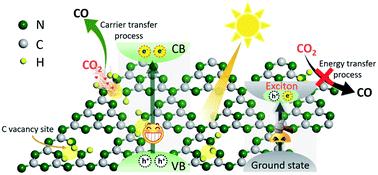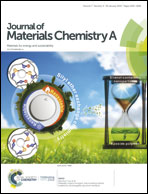Carbon-vacancy modified graphitic carbon nitride: enhanced CO2 photocatalytic reduction performance and mechanism probing†
Abstract
The obstacles to achieving high CO2 photoreduction performance on graphitic carbon nitride (GCN) are commonly ascribed to its weak CO2 activation capability and low charge carrier concentration. To overcome these obstacles, here we report a new class of GCN with C vacancies intentionally introduced by heat treatment in an NH3 atmosphere. GCN with enriched C vacancies exhibits more than two times higher CO2-to-CO conversion rate than pristine GCN. Our detailed characterization reveals that the improved CO2 reduction performance of this carbon-vacancy modified GCN is attributed to the enhanced CO2 adsorption/activation, upshifted conduction band and elevated charge carrier concentration and lifetime. Moreover, we discover that the introduction of C vacancies into GCN could attenuate the exciton-effect and favor the charge carrier generation. These results not only provide insights on regulating the structure of GCN to promote its CO2 photoreduction performance, but also pave the way to tune the exciton effect and charge carrier concentration in GCN to facilitate photoinduced electron–hole separation and charge-carrier-involved photocatalytic reaction.

- This article is part of the themed collection: 2019 Journal of Materials Chemistry A HOT Papers


 Please wait while we load your content...
Please wait while we load your content...